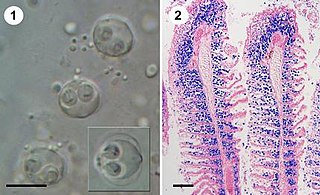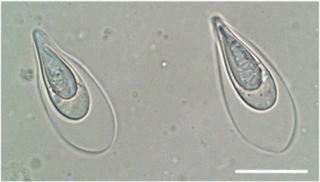
Myxosporea is a class of microscopic animals, all of whom are parasites. They belong to the Myxozoa clade within Cnidaria. They have a complex life cycle that comprises vegetative forms in two hosts—one an aquatic invertebrate and the other an ectothermic vertebrate, usually a fish. Each parasitized host releases a different type of spore. The two forms of spore are so different in appearance that until relatively recently they were treated as belonging to different classes within the Myxozoa.

Myxobolus is a genus of myxozoa that includes important parasites of fish like Myxobolus cerebralis. The genus is polyphyletic, with members scattered throughout the myxozoa. Some stages of Myxobolus species were previously thought to be different organisms entirely, but are now united in this group. Some fish species, such as the thicklip grey mullet, can harbour a dozen of Myxobolus species.
Kudoa thyrsites is a myxosporean parasite of marine fishes. It has a worldwide distribution, and infects a wide range of host species. This parasite is responsible for causing economic losses to the fisheries sector, by causing post-mortem "myoliquefaction", a softening of the flesh to such an extent that the fish becomes unmarketable. It is not infective to humans.

A xenoma is a growth caused by various protists and fungi, most notably microsporidia. It can occur on numerous organisms; however is predominantly found on fish.

The olive flounder, bastard halibut or Korean halibut is a temperate marine species of large-tooth flounder native to the North-western Pacific Ocean. It is the highest valued finfish in the world, known to be excellent for aquaculture due to a rapid growth rate and popularity in Korea.
Glugea is a genus of microsporidian parasites, predominantly infecting fish. Infections of Glugea cause xenoma formation.

Like humans and other animals, fish suffer from diseases and parasites. Fish defences against disease are specific and non-specific. Non-specific defences include skin and scales, as well as the mucus layer secreted by the epidermis that traps microorganisms and inhibits their growth. If pathogens breach these defences, fish can develop inflammatory responses that increase the flow of blood to infected areas and deliver white blood cells that attempt to destroy the pathogens.
Ceratomyxa is a genus of myxozoan.
Calyptospora is a genus of parasitic protozoa in the phylum Apicomplexa.
Kudoa paraquadricornis is a myxosporean parasite of marine fishes, first discovered in Australia from 4 carangid species.
Kudoa kenti is a myxosporean parasite of marine fishes, first discovered in Australia from 4 pomacentrid species.
Ceratomyxa hooperi is a myxosporean parasite that infects gall-bladders of serranid fishes from the Great Barrier Reef. It was first found on Epinephelus quoyanus.
Ceratomyxa whippsi is a myxosporean parasite that infects gall-bladders of serranid fishes from the Great Barrier Reef. It was first found on Cephalopholis boenak.

Enteromyxum leei is a species of myxozoan, histozoic parasite that infects the intestinal tract and sometimes associated organs, like gall bladder and liver, of several teleostean fish species. Myxozoans are microscopic metazoans, with an obligate parasitic life-style. The parasite stages of this species live in the paracelullar space between fish enterocytes. It is the causative agent of enteromyxosis, or emaciative disease, also known as "razor blade syndrome" in sparid fish. E. leei has a wide host and geographical range within marine fish, and even freshwater fish have been infected experimentally. E. leei initially emerged in the Mediterranean in the late 1980s and it is believed to have been unintentionally introduced into the Red Sea. Its pathogenicity and economic impact depend on the host species. In the gilt-head seabream, it is manifested as a chronic disease that provokes anorexia, delayed growth with weight loss, cachexia, reduced marketability and increased mortality. In other species, it has no clinical signs. In sharpsnout seabream, infection results in very high mortality rates, which have pushed fish farmers to abandon the culture of this fish species.

Sphaerospora molnari is a microscopic endoparasite of carp in pond cultures and natural freshwater habitats in Central and Eastern Europe. In natural infections, S. molnari invades the epithelia of gills and surrounding skin regions. It then forms spores in between epithelial cells, causing sphaerosporosis, a pathological condition of the skin and gill tissues. Affected tissues show marked dystrophic changes and necrosis, causing secondary bacterial infections and resulting in osmoregulatory and respiratory failure. Mortalities can reach 100% but little is known about the overall distribution of the parasite species in European carp ponds or its economic impact on carp aquaculture.

Thelohanellus kitauei is a myxozoan endoparasite identified as the agent of intestinal giant-cystic disease (IGCD) of common carp Cyprinus carpio. The species was first identified in Japan, in 1980 and later formally described by Egusa & Nakajima. Fan subsequently reported the parasite in China, and several other reports from carp and Koi carp in China and Korea followed. Reports referred to an intestinal infection, swelling and emaciation of fish due to blockage of the intestinal tract by giant cysts. The intestine of carp was believed to be the only infection site of T. kitauei until Zhai et al. reported large cysts of T. kitauei in the skin, with morphologically similar and molecularly identical spores. T. kitauei has been recognized as the most detrimental disease of farmed carp in Asia with around 20% of farmed carp killed annually. In 2014, the genome of T. kitauei was sequenced, and in 2016, its life cycle was found to include the oligochaete Branchiura sowerbyi. Infected oligochaete worms were first discovered in Hungary and raised concerns of the introduction of T. kitauei into European carp culture ponds, since it was believed to be endemic to Asia. However, the related disease (IGCD) has not yet been reported in Europe.

Henneguya is a genus of myxosporean parasites belonging to the family Myxobolidae.
Ellipsomyxa is a genus of cnidarian that is part of the family Ceratomyxidae.
Zschokkella are identified as parasitic organisms from the family Myxidiidae of the suborder Variisporina. This genus of Myxozoa tend to inhabit common areas of their host and can be found around the globe in both marine to freshwater habitats. Zschokkella also have spore shapes and host specific parasitism that differentiates it from other Myxidiidae.
Kudoa septmpunctata is a myxosporean parasite commonly found in raw olive flounders. The parasite is associated with food poisoning.











